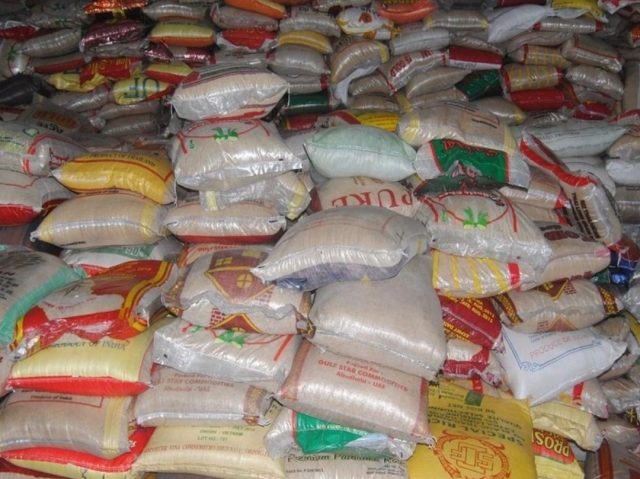Despite the country’s enviable position as Africa’s biggest rice producer and a leading figure in the commodity production, globally, it also ranks high as the third highest importer of the grain. Regardless of the various interventions targeted at stimulating revolution, especially in local production including the Federal Government’s Anchor Borrowers Programme (ABP); Abuja’s 1.2 million bags of rice pyramid, among other interventions, the industry appears to have defied all dynamics. From N30, 000 in September 2021, the price of a 50kg bag of the commodity has increased massively to an average price of N115, 000 in 2025, taking the commodity, considered as a major staple food in many homes beyond the reach of the common man, GBENGA AKINFENWA writes.
Three months ago, April, to be precise, Nigeria’s parboiled rice market slumped to a near two-year low, as supplies flooded the regional markets, forcing down price of the commodity. This development crashed price of rice, as a 50kg bag dropped from between N80, 000 and N100, 000 to N58, 000 in some parts of the country, particularly in remote areas.
Though the price drop came like a succour to the already-distraught Nigerians, who were battling to survive the economic hardship occasioned, significantly, by the policies of subsidy removal and the unification of the FOREX, their joy was short-lived, as the price suddenly rose to between N80, 000 and N100, 000 in July, forcing many to start seeking alternatives to their main menu.
Considering its position as Africa’s largest rice producer, stakeholders in the industry are worried that the country is still very far from self-sufficiency, taking into consideration all positive variables that should have oiled the attainment of such status.
Regardless of its position as top producer, between 2021 and 2025, the price of a 50kg bag of rice rose by 233 per cent. The Guardian gathered that the price rose from N30, 000 in September 2021 to an average price of N115, 000 as of January 2025.
Though the Federal Government has always claimed increase in local rice production, available information shows that the claim is only on paper, and far from reality. In fact, it was gathered that the country is on the verge of becoming world’s largest importer of the commodity going by the expanding demand gap.
According to the U.S. Department of Agriculture’s (USDA) Rice Outlook report, Nigeria is on track to becoming the world’s leading rice importer. This development places Nigeria at the centre of a global rice trade projected to reach around 52.85 million tons, signaling a significant opportunity for rice exporters, particularly from Asia and other continents.
The import forecast of 2.1 million metric tons by Nigeria underscores the country’s growing appetite for rice, presenting a lucrative market for international suppliers. This burgeoning demand positions Nigeria as a key player in the West African food and beverage market, offering a fertile ground for exporters looking to expand their reach.
This shift in Nigeria’s rice import strategy opens new avenues for exporters from Asia and other regions, who are now looking at West Africa as a promising destination for their products.
With its position as Africa’s biggest rice producer and one of the world’s leading producers, more than half of the rice consumed in Nigeria is produced locally, resulting in a supply deficit of approximately three million metric tons.
Taking into account the availability of the needed resources to be self-sufficient in rice production, reports have it that the produce is cultivated in almost all the states of the federation. In fact, 29 out of 36 states, cultivate rice with the exception of the Federal Capital Territory (FCT), Abuja, yet the country ranks third highest importer of rice with over 2.1 million metric tons imported yearly.
As part of moves to attain self-sufficiency in rice production, the Federal Government, over the years, introduced measures aimed at boosting the capacity of local farmers, but the outcome appears not commensurable with the investments. Some of the policies include bans and restrictions of rice importation, targeting both land borders and seaports.
Why Rice Sustainability Policies Appear Inconsistent
One of the key milestones on rice importation policy was introduced in October 1985 under the President Ibrahim Babangida regime, when the country imposed a ban on rice imports to curb foreign exchange depletion and encourage local production.
On January 2011, government also prohibited rice imports through land borders, restricting entry exclusively to seaports to reduce smuggling and ensure proper duty collection.
Four years after, July 2015 to be precise, a full ban on rice imports was introduced to promote self-sufficiency. However, this was partially lifted in October 2015, allowing imports through land borders upon payment of duties. The policy was reintroduced in March 2016 due to inconsistent enforcement and porous borders, which led to substantial smuggling, eroding government revenue and undermining local production.
This led to the restriction of rice imports exclusively through seaports with a 10 per cent tariff and a 60 per cent levy, translating to a total of 70 per cent on imported rice.
On April 2023, the government released the Import Adjustment Tax list for 2023 Fiscal policy measures, the previous policy of 70 per cent import duty was revised for importing paddy, and the government imposed a 10 per cent import duty and a 50 per cent levy.
In July 2024, the Federal Government, through the Customs Service, announced the temporary waiver of all import (and associated levy) taxes for some food commodities, including rice, until December 31, 2024.
As a result, husked brown rice import tariffs and duties went from 20 per cent to 0 per cent. This step was taken to ease food inflation, which had reached a peak of approximately 41 per cent in 2024.
However, despite these policies, local production capacity was fast plummeting, creating huge demand/supply gap and opening the window for further reliance on imports to bridge the supply deficit.
This development gave rise to Nigerians demanding update on rice production initiatives by some states. While the Lagos State came up with the Lake Rice initiative, which later became Eko Rice; Ogun created MITROS rice, while the likes of Kebbi, Ebonyi, Delta, Bayelsa and Kogi, among others, also followed suit.
The purpose of these rice brands was to ensure food security by ensuring that Nigerians buy the produce at a highly reduced price, compared to what obtained in the market. This is coupled with the advantage of eating fresh rice, which is safe for consumption, compared to the foreign brands.
And Local Rice Production On The Decline
THE decline, according to the report, was primarily driven by the high cost of fertilisers, leading to reduced yields, prompting many farmers to shift to alternative crops such as sesame and sorghum, which require less fertiliser and are also, more cost-effective to cultivate.
Also, it was learnt that widespread insecurity in major rice-producing states such as Katsina, Kebbi, Jigawa, Kwara and Sokoto states, has disrupted farming activities. Moreover, the challenges became worst with the severe flooding witnessed in several regions of the country. These factors, no doubt, have significantly impacted the availability and price of paddy rice, experts said, thereby raising concerns about food security and affordability for consumers nationwide.
A rice processor, who is the CEO of Wumsam Foods, Ile – Ife, Osun State, Adeoye Samson Madewa, who decried the lingering challenges bedeviling the growth of the industry, said the rice sector has seen a lot of policies and investments over the years, especially during the tenure of late President Muhammadu Buhari, yet the price of the commodity is on the rise, going beyond the reach of the average Nigerian.
“The rise in rice prices despite significant government interventions stems from a combination of systemic challenges in the rice value chain. Some of the real problems include inadequate infrastructure – poor road networks, lack of storage facilities, unstable power supply, increasing cost of production and post-harvest losses.
“High cost of inputs – fertilisers, improved seedlings, and agrochemicals are expensive and often scarce. This discourages smallholder farmers who produce most of Nigeria’s rice; insecurity in farming areas – banditry, kidnapping, and farmers-herders clashes have displaced many rice farmers, especially in key production states like Kebbi, Benue, and Borno.
“Dependence on rain-fed agriculture – limited irrigation infrastructure means that rice is mostly grown during the rainy season, reducing the possibility of multiple harvests per year; weak value chain and middlemen exploitation – middlemen often exploit the gap between farm gate and market, inflating prices for consumers while farmers earn little.
“There is also limited mechanisation – most rice farmers still use traditional tools and methods, reducing efficiency and increasing labour costs; and policy inconsistency and smuggling.
“Though the borders were closed to reduce importation, rice smuggling through porous borders persisted, creating market instability. Policies were also not consistently followed or effectively implemented,” he said.
In the same vein, report by the United States Department of Agriculture (USDA), had earlier forecast decrease in Nigeria’s rice production owing to higher fertiliser prices, reduced access to farmlands in conflict-prone areas and an increase in unrecorded imports of cheaper paddy, which made local paddy less competitive.

Another factor, according to industry analysts, is shortage of paddy rice. It was gathered that millers were forced to import raw rice, but the decision of Indian government in July 2023, which banned export of non-basmati rice to stabilise domestic prices, further worsened the situation. The ban led to the shutdown of many rice mills in Kano due to lack of paddy.
On his part, the Chief Executive Officer, Green Sahara Farms, Plateau State, Suleiman Dikwa, attributed the problem of the industry to low paddy supply and milling capacity constraints.
“There has been a significant reduction in the availability of paddy rice, which is directly impacting the supply chain. Factors such as reduced cultivation areas due to security challenges and challenges in farming practices due to climate change have contributed to this scarcity.
“The milling capacity is more than the cultivated paddy. Therefore, demand for paddy pushing prices, leading to inefficiencies and bottlenecks in processing. This disparity between paddy supply and milling capacity exacerbates the price increase, creating produce shortage.”
Sadly, the alleged hoarding and market dynamics, which was identified as part of the reasons for scarcity of paddy rice, created a supply gap, making it accessible only to the highest bidders.
Findings by The Guardian revealed that rice millers and marketers were going directly to houses to purchase paddy. Wealthy individuals with liquid cash were equally reportedly to have been buying up entire community supplies and dictating prices.
Further investigations showed that the several previous efforts haven’t gone down in vain, as it has led to a significant shift in the industry.
It was learnt that Nigeria’s rice milling business is currently undergoing significant industrialisation, as more than 100 mills are in operation, with growing capabilities in processing capacity, parboiling, and packaging. Also, integrated companies are getting involved with contract farming schemes, providing critical linkages to small farmers and assuring paddy supply to mills.
But this is not reflecting, as the agric sector is still beset with a high cost of production, whose impact is directly on the price competitiveness of Nigerian rice compared to low-priced imports from other countries.
Repositioning The Industry For Self-sufficiency
To reposition the industry for the purpose of ensuring self-sufficiency and reduction of price sustainably, Madewa suggests the need for farmers to invest in irrigation and mechanisation, as this will expand access to irrigation systems to enable all-year-round farming and reduce dependence on rainfall and also provide subsidised or shared-use farm machinery to boost productivity.
He said: “There is need to strengthen input supply and research – subsidise and ensure timely delivery of quality seeds, fertilisers, and agrochemicals and promotion of agricultural research to develop high-yield, pest-resistant rice varieties suited for local environments; enhance security in farming communities – implement targeted security measures to protect farmers and farmlands in key agricultural zones.
“Efforts should be made to improve infrastructure and storage – invest in rural roads, modern storage systems, and transportation logistics to reduce post-harvest losses and transportation costs; encourage cooperative farming and clusters – support farmers to form cooperatives or clusters for better access to finance, inputs, training, and markets. Tightening of border control and elimination of smuggling – strengthening customs and border patrols to effectively check rice smuggling and protect local producers.
“Private sector partnership and incentives is also essential. This will create a business-friendly environment to attract private investment in rice milling, packaging, and distribution; and stable and long-term policy framework – by avoiding abrupt policy changes. Develop and implement a long-term rice development strategy with stakeholder input.”
Madewa noted that if the policies are properly implemented, they can significantly boost local rice production, improve affordability, create jobs, and ensure food security in Nigeria.
A professor of agriculture, Babagana Gambo, recently disclosed at a forum in Abuja that the country can bridge the gap between rice production and its consumption, through three ways – planting of rice in both wet and dry seasons; giving more lands for the production of rice; and non-importation of rice into the country.
He noted that self-sufficiency in rice production, among other food items, was one of the ways the Buhari-led administration tried to lessen pressure on foreign exchange, by reducing importation, creating jobs and spurring diversified growth.
The Guardian investigations showed that the rice industry received a massive support from the Federal Government under the late President Muhammadu Buhari administration. The most stimulating support was the Anchor Borrower Programme (ABP) implemented through the Central Bank of Nigeria (CBN).
The programme, launched in November 17, 2015, was aimed at creating a market for the farmers by establishing a link between companies involved in the processing of agricultural commodities that were produced by small holder farmers.
The revolution in rice production across the states that participated in the scheme, based on reports, indicates that the farmers did not only improve in their revenue base but also in their technical ability as yield per hectare rose tremendously.
It was learnt that the number of the beneficiaries of the loan under the scheme swelled enormously, also signifying that the project was embraced by the rice farmers.
The CBN was the Federal Government’s body that bankrolled the loan programme, with each beneficiary expected to get agro inputs and cash, put together as the loan package. Before the loan was disbursed, an economic cost of production per hectare of rice farm was carried out by the CBN to determine how much a farmer should benefit per hectare of farmland.
For instance, in Kebbi State, where the programme took off, rice farming was on the verge of collapse as at the period when the intervention was introduced, having dropped to as low as 1.5 tons per hectare, and a complete absence of off-takers.
Farmers couldn’t even produce at break-even, let alone, having a profit margin, a situation that compelled many to abandon rice farming for other alternatives.
Worried by the unsustainable scenario, the state government contacted the Federal Government over the sad trend, which intervened with heavy investment in rice production, with a view to resolving the situation.
It was gathered that after the ABP’s intervention, the state recorded significant impact as its yearly rice production capacity shot from 700 metric tons in 2015 to 3.5 million metric tons in the following harvest season.
The same was reported across the participating states at the period, but sadly, the ‘magic’ did not translate to anything, especially the alleged fraud that charaterised the operationalisation of the scheme. Despite the billions of naira expended on the scheme to transform the rice industry, the country is still in the teething stage.
Another major step taken by government was the unveiling of the 1.2 million bags of rice pyramid in January 2022 in Abuja. The unveiling, done in a fanfare ceremony with at least presidents of three neighbouring countries, was adjudged the world’s largest rice pyramid.
At the period, a 50kg bag of rice costs between N23, 000 and N27, 000, there was high expectation that the unveiling would bring down the price of the commodity.
But in spite of these interventions by the Federal, ‘huge production’ across the states, and other interventions by the private sector, the price of the staple food has continued to fluctuate even before the 2022 figure.
For instance, in 2021, the price of rice began to soar after the government decided to withdraw from the ABP, due to farmers’ inability to repay the loans.
Based on market trend, in July 2021, a 50kg bag of Nigerian rice was sold at about N30, 000 but by September 2022, the price had increased to N40, 000, marking a 33.3 per cent rise in cost. In 2023, prior to the emergence of President Bola Ahmed Tinubu, the price fluctuated between N42, 000 and N50, 000.
After the removal of the fuel subsidy on May 29, 2023, the price of the staple began to rise astronomically on a weekly basis, and at times, monthly.
According to the National Bureau of Statistics (NBS), local rice prices in Nigeria surged by 137.32 per cent in October 2024, compared to the same period in 2023. The NBS reported that in January 2024, the average price of local parboiled rice surged by 98.47 per cent, due to scarcity of paddy across the country.
The Bureau, in its Selected Food Price Watch Report, showed that the average price of 1kilogramme of local parboiled rice rose to N1, 021 in January 2024 from N514 in January 2023.
Despite the huge budgetary allocations, the states claimed they expended on the project, their rice brands have vanished from the markets, except Lagos government, where the Eko rice is still intact, though appears irregularly.
It is because of this mixed fortune that Nigerians can’t fathom why the country remains import-dependent despite several efforts and the renewed drive by the Federal Government to achieve rice revolution dream.







